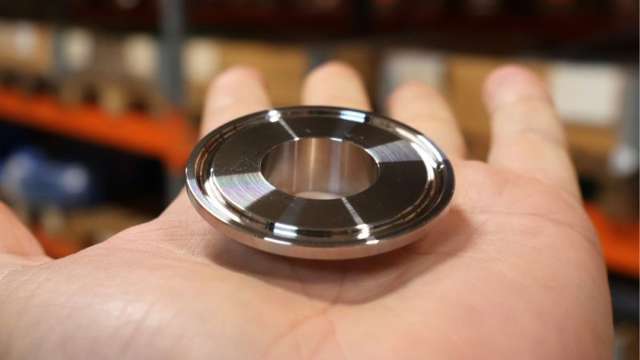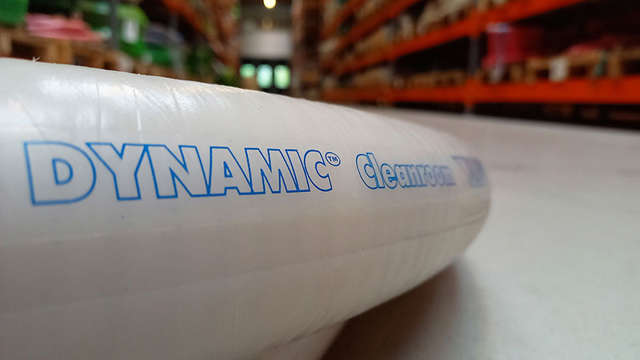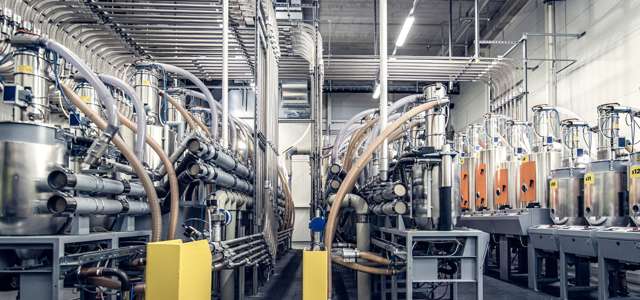Surface roughness is an important factor in the design and operation of equipment in food and pharmaceutical production. It affects both cleaning efficiency and the risk of bacterial growth and, ultimately, the shelf life of the product. A smooth surface (with a low Ra value) reduces the risk of contamination, while a rough surface can form hidden pockets where bacteria thrive and biofilm can take hold. This can lead to hygiene failures, even if the raw materials are fine.
How does surface roughness interact with the choice of fittings, standards and hose solutions, and what does this actually mean in practice for hygiene in a plant? Let's take a closer look.
Read on and learn more!
What is surface roughness?
Surface roughness refers to microscopic irregularities that cannot be seen with the naked eye but are very important for hygiene. It’s measured as the Ra value, which is the average height of the small peaks and valleys on the surface. The lower the Ra value, the smoother the surface.
A mechanically polished surface typically has a Ra value of maximum 0.51 μm, while an electropolished surface can be as low as 0.38 μm. But here's the important thing: a low Ra value does not automatically mean that the surface is easier to clean. Why? Because the Ra value only tells you about the average – i.e. how high and deep the microscopic irregularities on the surface are – but nothing about how they’re distributed.

Two surfaces with the same Ra value can behave very differently in practice. If the grooves are deep and narrow, or run in the same direction, it can be difficult for cleaning fluids to reach all the way in. This allows dirt and bacteria to easily hide. Even after thorough cleaning, they can survive and form biofilms, which are difficult to remove and can impair both food safety and product shelf life. A smooth, evenly polished surface, on the other hand, provides fewer places for bacteria to attach themselves. It’s easier to clean, dries faster and reduces the risk of cross-contamination between production runs.
That’s why it is not enough to look at the number alone. The surface structure plays an equally important role. It’s not just about what the measuring instrument shows, but how the surface looks in reality when exposed to food, cleaning and daily operation. In other words, small irregularities can have major consequences if they’re not taken seriously.
Sanitary requirements: ASME BPE vs. DIN and ISO

Once you understand how much surface roughness matters for hygiene, it becomes clear why standards such as ASME BPE, DIN and ISO aren’t just technical formalities. Different industries have different requirements – both for surface smoothness and for the documentation that accompanies it. It’s therefore no coincidence that the standards are widely used in both food and pharmaceutical production, where the requirements for cleaning and traceability are high.
ASME BPE is typically used in the production of medicines, where hygiene and traceability must be of the highest standard. Here, companies prefer a surface roughness of down to Ra 0.38 using electropolishing. ASME BPE is not just a standard, but a comprehensive set of rules that also includes requirements for material selection, welding procedures, inspection and documentation. It has been developed for environments where there‘s no room for compromise – and where every surface and joint must be validatable and traceable. A good example of this standard is our ASME BPE clamp liner (Tri-Clamp), which comes with a maximum surface roughness on the inside of either Ra 0.51 μm or Ra 0.38 μm.
In the food industry, where requirements remain high, both DIN and ISO standards are more widespread. Here, Ra values of up to 0.8 μm are typically sufficient to ensure a cleanable surface, especially in connection with CIP cleaning. For example, the DIN clamp liner in AISI 316L is a robust solution for this purpose, especially among breweries and dairies.
Common to ASME BPE, DIN and ISO is that they set clear requirements for surface roughness – and thus for the hygiene safety of the entire system. They therefore play a crucial role when selecting components with a view to ease of cleaning, bacterial risk and process requirements. Whether you are working with hoses, fittings or fixed pipe connections, the standard behind them should always be considered – because that’s where surface quality begins.
Surface roughness, fittings and hose – one hygienic system
When flexible hoses are part of a process system, the choice of couplings and surface roughness is just as important as the hose itself. It is not just a question of tight connections, but of ensuring a hygienic whole – from the inner finish of the hose to the contact surface of the clamp liner.

Three examples of hose solutions where standard, surface quality and application come together:
- Dynamic Cleanroom is designed for pharmaceutical and biotechnological production where hygiene plays a crucial role. The inner PFA liner has a mirror-smooth and chemically resistant surface – ideal for sterile environments and CIP processes. When combined with an ASME BPE clamp liner (Tri-Clamp) with an electropolished finish (Ra ≤ 0.38 μm), the solution minimizes the risk of biofilm and prevents residues and microorganisms from gaining a foothold.
- Maniflon/SD-PTFE handles aggressive chemicals and pharmaceuticals in both food and pharmaceutical production – even in ATEX-classified areas. The hose has an antistatic PTFE inner hose and an EPDM outer layer, both of which contribute to electrical conductivity through the hose wall. A steel spiral and copper wires ensure effective dissipation of static electricity. If you also choose one of our compatible AFT hose couplings, you'll achieve a strong and tight connection that can withstand both pressure and repeated loads. With a surface roughness of up to Ra 0.8 μm, the hose fits well into systems where chemical resistance and hygiene are equally important.
- Liquorflex/SD supports the transport of alcoholic beverages with up to 98% alcohol concentration. The smooth UPE inner liner ensures that neither taste nor odor affects the product, while the synthetic rubber outer surface – which is both wear-resistant and resistant to ozone and weather – protects against external influences. Copper wires and steel spirals safely conduct static electricity away. Regardless of the standard (i.e., clamp, DIN, or ISO), AFT hose couplings are particularly well suited for Liquorflex/SD, as they enable quick assembly and disassembly. This is especially important in beverage production, where equipment is often moved or cleaned manually.
In all three cases, surface roughness is not just a number. It is a choice that has a direct impact on operational reliability, cleaning and hygiene. And when fittings and hoses work together, the result is a complete solution that keeps bacteria out and the line running.
Book a meeting with us today
Our specialists have solid experience in putting together fittings and hoses that match both surface roughness and hygiene requirements. Book a meeting and get advice on the solution that best suits your process. Contact us via inquiry@alfotech.eu or call +45 7020 0422.
 da
da
 de
de
 en
en
 sv
sv
